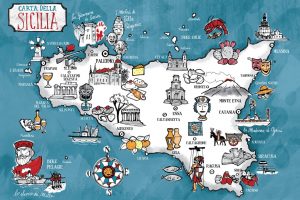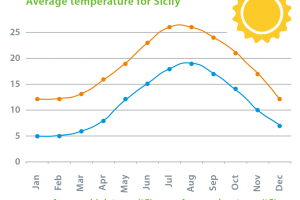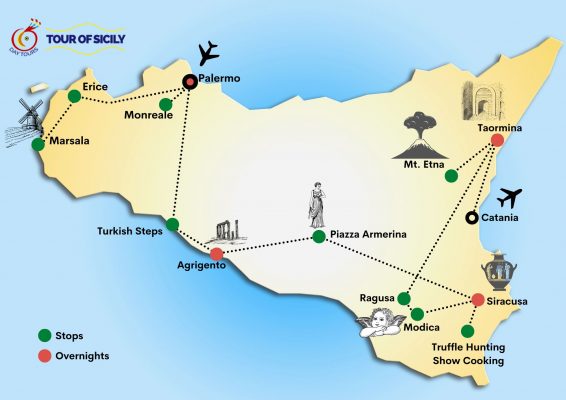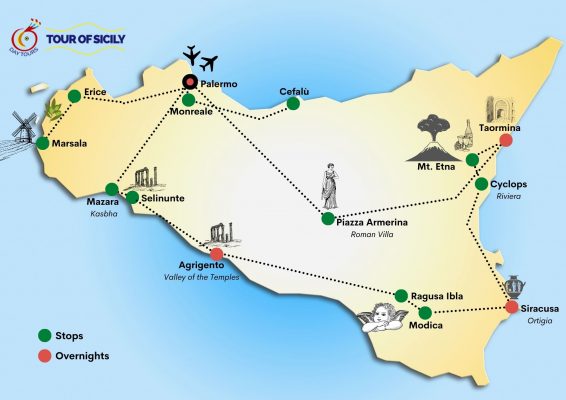12 Days in Sicily
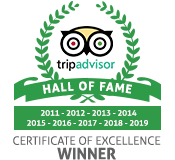
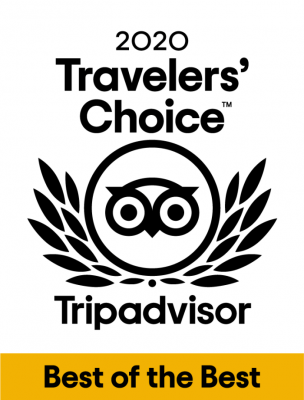
Personalized Trips to Sicily
Let me introduce you the 12 day-tour which is a good way to explore the most important local highlights of Sicily. We have shown a few different solutions which involve the west, the east, the south and the south-east.
Feel free to verify which is the one that fit your needs and expectations and in case you wish us to customize your tour feel free to share with us your needs.
Sicily at a glance
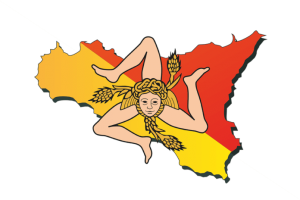 Sicily, the largest island in the Mediterranean, is a captivating blend of ancient architecture, beautiful, hidden away beaches and a bustling capital full of charisma and authentic charm.
Sicily, the largest island in the Mediterranean, is a captivating blend of ancient architecture, beautiful, hidden away beaches and a bustling capital full of charisma and authentic charm.
Thanks to its geographical location, Sicily has had the major role in the historical events that have played a key role in the Mediterranean.
The not-to-be-missed cities of Sicily
Palermo. Palermo bears witness to its past—conquered by the Phoenicians, Arabs, and Spanish, its churches and archeological remnants are unrivaled. Then the Palazzo dei Normanni and its Byzantine mosaics never fail to awe visitors; Normal Royal Palace and Palatine Chapel are divine; golden beaches of Mondello Lido, the foodie delights of the city’s markets, the Botanical Gardens—all are must-see sights in Palermo.
Monreale. The city’s Duomo is one of the greatest medieval treasures in the world—the 58,000 square feet of mosaics will take your breath away.
Siracusa and Ortygia Island. Archimedes, Cicero, Saint Paul, Caravaggio, and the naval hero Lord Admiral Horatio Nelson all made their presence known in Siracusa. In fact, Aeschylus premiered his plays at the still-functioning Teatro Greco here. One of the most beautiful squares in Italy, the Piazza del Duomo, is in the tiny island of Ortygia
Taormina. Perhaps there is no more famous name in Sicily than Taormina. This resort town draws the international jet set to its romantic alleys and glittering hotels. But Taormina is steeped in ancient history and mythology—Giardini-Naxos, Teatro Greco, and the Norman and Baroque monuments are all worth a visit.
Of course, Mt. Etna, Europe’s highest volcano, is in Taormina, and no visit to Sicily would be complete without gazing at its stunning vistas.
Mt Etna, locally called “Mongibello”, is Europe’s largest and most active volcano. Its frequent eruptions are often accompanied by large lava flows, but rarely pose danger to inhabited areas. Etna is one of the volcanoes with the longest historic records of eruptions, going back more than 2000 years. Read More
Marsala. The city is more than the sweet wines which bear its name and for which the city is famous (but don’t miss the historic Florio Winery and the Donnafugata Winery). You’ll also want to see Marsala’s salt marshes—and be sure to try busiati, the oldest handmade pasta in the world. Read More
Trapani. Ornate churches like the Cattedrale di San Lorenzo and the Torre della Colombaia define the architecture here. Don’t miss shopping for the city’s famous exquisite coral jewelry.
Ragusa. Ragusa Ibla is a fairytale of church domes and terracotta roofs. The Duomo di San Giorgio, the Giardino Ibleo, and the 18 listed UNESCO monuments will delight you.
Agrigento. The city’s greatest draw is the Valley of the Temples and its ancient Greek ruins. Tempio della Concordia is one of the best-preserved temples in the world. You’ll definitely want to visit the Museo Regionale Archeologico, perhaps the best museum in Sicily, which features the famous stone statue of Telemon (Atlas).
Catania. In a perfect world, you’d devote two full days to the art, museums, and Roman ruins of Catania. Don’t miss Duomo Square, La Pescheria (the fish market), and the Bellini Gardens.
Erice. This western Sicily gem is famous for its almond biscuits (the pastry shops here are without equal). Erice’s main church and bell tower are striking, as is the Norman castle, also known as Venus Castle, a tribute to the goddess of fertility.
Or what about Sicily’s unique cuisine—Arab and Greek spices, Spanish techniques, the world’s finest seafood. And it’s all accompanied by big, fruity, out-of-this-world wines.
Sicilian food is also considered the original fusion cuisine, a unique mix of all of its diverse cultural heritages.
The island has been at the heart of thirteen different empires over the last three millennia, and each one of them has left its mark on the Sicilian Gastronomy.
Must-try Local Dishes and Wines
Pasta alla Norma – pasta served with a special sauce made of tomatoes and fried eggplant with ricotta cheese
Arancine – fried rice balls coated with breadcrumbs and often filled with cheese or ragù sauce
Cannoli – a tube shaped pastry that is stuffed with a sweet, creamy filling often made from ricotta cheese. Read More
Caponata – a typical antipasto that you’ll encounter in every corner of Sicily; a delicious sweet and sour (agrodolce) mixture of fried eggplant, onions, celery, tomatoes, vinegar, capers, and olives, sweetened with a bit of sugar. Read More
Almond Cookies – a famous local dessert typical of Sicily. Soft and tasty, they are fast to make (and to eat…). They are also a gluten-free dessert. Read the recipe
The Chocolate in Modica – made with a very old recipe, the one coming from the Aztecs. Read More
The Predominant Grapes – Historically, Italian wine regions have clung tightly to its historical grapes, and Sicily is no different. While international varieties are prominent players, for critics, sommeliers, and importers, the wines they dream about at night are indigenous. There are three key red grapes: Nero d’Avola, Frappato and Nerello Mascalese.
Information
Travel Tips
If it is your first time to Sicily, get ready for an incredible experience!
The prospect of visiting Sicily for the first time will provoke a wide range of emotions. For some, traveling to a foreign land-especially one that doesn’t speak English – is so intimidating that any real enjoyment can only be realized with the help of a native to navigate through all the unfamiliar turf. For others, even those who don’t speak Italian, the opportunity to be immersed in an entirely new culture is part of the fun, and they look forward to feeling their way through each of the novelties that Italy throws at them.
Tipping
- Taxis: Government-regulated taxis are either white or yellow. Avoid taxis that are not metered and have no official signs. They are private cars that will charge you an expensive fee. Unlike in the U.S. where taxis are hailed on the street, in Sicily they are found at taxi stands or are called by telephone. All charges are listed on a price chart displayed inside the cab. Extra charges are in effect at night, for luggage service and phone booking. A 10% tip is expected but not mandatory.
- Restaurant tipping: Both il servizio (service charge/tip) and il coperto (cover charge for bread and water) are usually included in il conto (the bill). By Sicilian law the gratuity is included in the bill so extra tipping isn’t required. However, it is customary, especially if the service is good, to leave an additional gratuity between 5% and 10%.
- Hotel Tipping: Tipping in hotels is a customary practice. The service charge of 15% – 19% is already included in your bill. Other suggested tips include 50 euro cents per day to the chambermaid, 50 euro cents to the doorman for calling you a cab, and between 1 and 2 euros for the bellhop if he carries your bags to your room. The concierge expects about a 15% tip on his or her bill, as well as tips for any extra services. If you are staying at a 4- or 5-Star hotel these suggested amounts should be doubled.
Useful Knowledge:
- Shopping: Italian stores generally are open from 9 a.m. to 1 p.m. The siesta/pausa lunch break lasts until 4 p.m. Stores close for the day by 8 p.m. Most stores are closed on Sunday.
- Café Culture: While enjoying an espresso at a table is always possible, the locals enjoy standing at the banco, or bar area.
- Hand Gestures and Loud Voices: Unlike in the U.S. of A., hand gestures and loud voices can be a way of expressing profound happiness.
Hotel Information:
- Hotels: When looking for a place to stay, remember that rates include taxes and service; the IVA (value-added tax, currently 10%) should be added to the total amount.
- Electrical: Not all hotel rooms provide hairdryers; if you bring your own, an adapter/transformer is a necessity. This will also be important for all other electrical devices, including laptop computers, because in Italy the voltage is different (220). Also, outlets have two round-pronged plugs, which is another reason an adapter plug is necessary.
Just the Basics:
- Sicily’s Time Zone: one hour ahead of Greenwich Mean Time (GMT+1). Sicily is generally six hours ahead of Eastern Standard Time in the United States, aside from the rare instances affected by the Spring Forward/Fall Back clock-changing discrepancy when the difference is five hours.
- Country Code (for international calls to Italy): +39.
- Currency: Euro. Available in bills of 5, 10, 20, 50, 100, 200, and 500 euros; coins of 1 and 2 euros and 1, 2, 5, 10, 20, and 50 euro cents.
- Official Language: Italian and Sicilian
- Flag: The Italian tricolor is green, white, and red, in three vertical bands, equal in dimension. The Sicilian flag shows a triskeles symbol (a figure of three legs arranged in rotational symmetry), and at its centre a Gorgoneion (depiction of the head of Medusa) and a pair of wings and three wheat ears.
- Religion: Roman Catholic is the main faith – 85% of native-born citizens are nominally Catholic. There are substantial Protestant, Jewish, and Muslim communities.
- Education: Sicily has statewide education system, with a five-year primary stage and an eight-year secondary stage.
Currency
Like other member countries of the European Union, Sicily uses the euro, symbolized by “€”. For the current conversion rate between your currency and the euro you can check a currency exchange Web site such as www.xe.com
ATM Cash Machines (bancomats) are everywhere in Sicily as they are in the United States. The Cirrus and Plus systems are the most widely available. Be aware that many Sicilian cash machines will not accept card with PIN codes, five numbers or longer so be sure to reset your PIN to a four numbers before you go. You may also have a problem accessing a savings account so be sure the ATM card(s) you are bringing are linked to checking accounts. You may also be able to use your credit card for a cash advance if it has a PIN code (fees will apply).
Many travelers wonder about bringing travelers checks with them and it simply isn’t a good idea anymore. You’ll pay a fee for the checks at home, will need to find a bank (banks are usually open for a few hours in the morning and a few hours in the afternoon on week days) when it is open, wait in line and pay another service fee when receiving euros.
Credit cards are widely accepted throughout Sicily. Visa and MasterCard are more commonly accepted so if you’re bringing an American Express card, be sure to bring a Visa/MasterCard as well. Many credit card companies (Capitol One is an exception) are now charging a transaction fees for international purchases. Be sure to check with your credit card company before leaving home. Finally, cash is king in Sicily. Sicilian merchants hate paying service fees on credit card transactions and will often give you a discount (sconto) for paying cash. Of course, they also like to hide their earning from the tax authorities too, but that’s a whole other story.
Shopkeepers are also open to giving discounts if you are buying multiple items. Don’t be afraid to ask for a sconto!
City Taxes
When staying overnight in Sicily, certain cities have a tourist tax.
This Sicily City tax must be paid by the PASSENGER directly to the hotel before the end of the stay.
| City | 5 star | 4 star | 3 star | |
| Palermo | eur 3 | eur 2 | eur 1.50 | |
| Catania | eur 2.50 | eur 1.50 | eur 1.50 | |
| Taormina | eur 5 | eur 3.50 | eur 2 | |
| Syracusa | eur 2.50 | eur 2 | eur 1.50 | |
| Agrigento | eur 3 | eur 2 | eur 2 | |
| Trapani | eur 3 | eur 2.50 | eur 2 | |
| Ragusa | eur 2.50 | eur 1.50 | eur 1 | |
| Cefalù | eur 3 | eur 2 | eur 1.50 | |
| Messina | eur 4 | eur 2 | eur 1.50 |
Internet
Wireless access is prevalent in restaurants and hotels and most hotels no longer charge for you to use WiFi.
You can access it with your phone or laptop computer.
If you choose not to bring a device with you, most hotels make a desktop computer available for guests to use or have a business center available.
Sicily airports
There are four airports in Sicily, two serving the east coast (Catania and Comiso airports) and the other two (Palermo and Trapani airports) – the west coast.
Palermo Falcone & Borsellino (PMO) and Catania Fontanarossa (CTA) are the biggest airports operating actively all the year round. Both become very busy in summer months.
Trapani Birgi (TPS) and especially Comiso Pio La Torre airport mostly serve low-cost airlines and seasonal flights.
Air, sea or land?
There are ways to get to Sicily from mainland Italy or from Malta without flying.
These include long-distance buses from other regions in central (mainly Rome) and southern Italy, trains or ferries.
However, flying to one of the Sicily airports is probably the fastest, and arguably the most convenient way to arrive at your final destination.
Busy itinerary? Fly anywhere!
If you are planning to explore the island and change your location at least two or three times it does not make much difference which airport to arrive.
You can even consider to arrive at one airport and depart from the other.
This is usually convenient and optimizes timing in case you want to move around and see more. Typically Palermo and Catania would be the preferred options.
Having a clear idea of what kind of a vacation you are planning to have, and what is your itinerary will make the choice of the airports easier. It is also possible to build an itinerary around your arrival and departure points, especially if your plans are not overwhelming.
Still, east or west – what is best?
Roughly speaking, Palermo airport is an optimal arrival point to reach destinations along the west coast between San Vito lo Capo and Cefalu. Corleone and the Madonie mountains would be on the same list, just a bit away from the coastline. Trapani airport is closer than any other one to Castellammare del Golfo, the Egadi islands including Favignana, Marsala, Erice, Segesta, Mazzara del Valo and Selinunte. The southern coast from Agrigento to Trapani itself is also within easy reach.
Catania airport serves best final destinations like Taormina, the Aeolian islands, Messina, Giardini Naxos, Acireale its coast, Etna, Siracuse and Noto, Caltanissetta. Comiso is optimal for Ragusa, Scicli, Modica and Licata, while Piazza Armerina and Caltagirone are similar travel distance from both Catania and Comiso airports. Agrigento, Tindari and Enna are equally convenient from Catania and Palermo airports with Agrigento and Tindari taking some 2 -2,5h drive. These are probably the farthest among popular locations on mainland Sicily. Agrigento is similar 2 – 2.5 h drive distance from Trapani and Comiso as well.
Visiting Sicily: days, weeks, and beyond
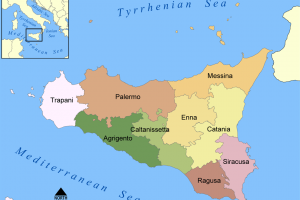 Sicily is an island and has 9 provinces (Palermo, Agrigento, Caltanissetta, Catania, Enna, Messina, Ragusa, Siracusa, Trapani), each with its own identity.
Sicily is an island and has 9 provinces (Palermo, Agrigento, Caltanissetta, Catania, Enna, Messina, Ragusa, Siracusa, Trapani), each with its own identity.
Landscapes, cuisine, and dialect differ greatly from one to the next, and each merits its own visit.
If your time is limited, you’ll be able to see Sicily’s highlights in a matter of days—but spending one week or more means you’ll get to explore multiple provinces and fall in love with the authentic Sicily.
If you have a few days in Sicily, it’s best to focus on one city, otherwise you’ll likely feel like you’re spreading yourself too thin!
In three or four days lodge in one city only and from here explore and enjoy the area.
The most important cities are Palermo — located on the west side — Taormina and Syracusa — both located on the east –.
In one week, you’ll be able to explore Sicily’s wonderful cultural cities, undoubtedly a highlight of any trip to the country. Palermo, Agrigento, Taormina and Syracusa attract the bulk of tourists and justifiably so—they harbor some of the world’s most impressive architecture and works of art.
Nine days will give you more time to explore what Sicily offers beyond the usual tourist destinations. You’ll be able to travel along the stunning Marsala, Erice, Ragusa, Modica and Noto, which offer some of Europe’s most enchanting scenery.
However, to experience Sicily at its best, you’ll need to factor in two weeks. That way, you’ll have enough time to discover a large part of the island and one (or perhaps both!) of its major islands, Lipari and Vulcano.
Interesting facts
 Treat yourself with the amazing Original Cannoli, a Sicilian speciality made of crispy dough and a creamy ricotta cheese filling.
Treat yourself with the amazing Original Cannoli, a Sicilian speciality made of crispy dough and a creamy ricotta cheese filling.
A dessert now known and appreciated all over the world, a pillar of “Sicilian Culture“. We can safely say that visiting Sicily without eating cannoli is like not having visited it at all.
For those who do not know it (We doubt there is someone who does not know what we are talking about) the Sicilian cannoli is a dessert consisting of a crunchy fried wafer in lard, called “scorza (rind)“, filled with sheep’s ricotta cream with a sprinkling of chocolate or pistachio and candied fruit at both ends.
Explore Sicily in 12 days
Sicily is a perfect destination for those who love art, delicious food, aromatic wines and breathtaking landscapes.
Despite its small territory unlike other Italian regions, Sicily claims years and years of history, incredible cultural wealth and folkloristic differences in every corner, which makes it a unique and inimitable country.
Highlights
11 nights – 12 days
Palermo (3 nights) Agrigento Country Area (2 nights) Siracusa (3 nights) Taormina (3 nights)
1st day – Arrival in Palermo airport – Transfer to Palermo
2nd day – Monreale, Palermo, Street Food Tastings and Cooking Class with dine with locals
3th day – Wine, Walk Along the Saltpan Pools and Olive Oil Experience (with Marsala and Erice)
4th day – Palermo to Agrigento Country Area (with Turkish Steps and Valley of the Temples)
5th day – Agrigento Country Area Half Day Organic Cooking Class with zero-mile ingredients
6th day – Winery and move to Siracusa (with Roman Villa Mosaics Floor)
7th day – Siracusa and Ortigia Half Day
8th day – Truffle Hunting, Bread, Cheese Show Cooking and lunch in an old watermill
9th day – Siracusa to Taormina (with Ragusa Ibla, Focacce, Modica and Aztec’s Chocolate)
10th day – Taormina Half Day
11th day – Etna WD4X4 and Wine Experience with lunch
12th day – Departure from Catania airport
The twelve day tour begins on the second day with a visit of Monreale to see with our expert Guide where the Arab-Norman art and architecture reached the pinnacle of its glory with the Dome. Launched in 1174 by William II, it represents the scenes from the Old and New Testaments all in golden mosaics. We then return to Palermo by taxi and with the guide we start a walk into a lively open-air market, a place with strong Arab influences, resembling a souk, with picturesque stands of fresh fish, cheese, fruit and vegetables. During the tour you will have the opportunity to observe local people in their daily activities and to savor foods that real Sicilian people love to eat! A small tasting of typical street food is included. The walking tour through the ancient center of Palermo is approx. 2 hours and an half and you will visit several monuments including Pretoria Square and the exterior of Cathedral.The tour will finish at the Four Corner to permit to have a few hours at leisure to explore Palermo on your own.
At h 5.30PM a shuttle service will pick you up and move you to a private house. Upon arrival the house-chef will welcome you and introduce you to his family. This is the best way to indulge your self in the real local Palermo life, cook with locals and dine at their house. At the end of the cooking class enjoy a delicious dinner.. Learn More
This afternoon departure for Erice uptown. The Elymians settled in the medieval town of Erice, which was an important religious site associated with the goddess Venus. Wander through its ancient streets and visit some of the famous homemade pastry shops—world-famous for marzipan candies and other delicacies like almond and pistachio pastries. At arrival, independent walk along the city centre with stop at local pastry shop to taste some Sicilian local sweet. Later we return to Palermo. Learn More
If you want to discover the Baroque beauty secrets, this is the tour for you! An incredible full-day dedicated to the exploration of two fascinating UNESCO heritage sites: Ragusa Ibla and Modica.
Today departure from Siracusa in direction of Ragusa Ibla. Our Team will offer you time at disposal to keep the feeling with this section of the town giving you directions on how to explore independently the old part of the city and an undisputed reality of Baroque art. Here you can admire numerous eighteenth-century churches and buildings and the Gardens. Soon after, you will discover another jewel of the Sicilian Baroque: Modica. Lunch in a typical trattoria to enjoy the food specialties of this side of Sicily where a strong Spanish influence is still alive. Obviously, you will have the opportunity to taste the local chocolate made following the tradition that originated from the Aztec of central America brought in Sicily from the Spanish in the 17° century. Then we drive on to Taormina. Learn More
Today meet the off-road’s driver and transfer to Etna Volcano. During our first stop we will discover a unique canyon comprised of basaltic lava (the “Alcantara Gorges”) and shaped by the waters of the Alcantara river. The Alcantara’s vertical cliffs reach 30 meters in height and its structures have been forged by high intensity geological and geothermal events. In prehistoric times, a river flowed here over clay sediments until a massive volcanic eruption channeled magma into the riverbed forming the current canyons. After this stop, we will traveling through one of the wine roads of Sicily and crossing large expanses of vineyards (Etna D.O.C.), we will arrive at a local winery. This is the ideal place to enjoy relaxing moments surrounded by nature while sampling a lunch and excellent wines.
We will then make a brief stop at the 2002 lava flow reachable by jeep through a winding dirty road surrounded by chestnut and oak forests. The 2002 eruption lasted from October 27th to January 29th 2003 and it is considered one of the most explosive eruptions of the past one hundred years. Later, driving up along the Mareneve road we will reach Piano Provenzana (1800 meters above sea level), a ski resort, theater of the great eruption of 2002. After a short walk to visit the ruins of the hotel Le Betulle destroyed by a molten lava flow. Learn More
Explore Sicily in 12 days
Sicily is a perfect destination for those who love art, delicious food, aromatic wines and breathtaking landscapes.
Despite its small territory unlike other Italian regions, Sicily claims years and years of history, incredible cultural wealth and folkloristic differences in every corner, which makes it a unique and inimitable country.
Highlights
11 nights – 12 days
Palermo (4 nights) Agrigento (2 nights) Siracusa (2 nights) Taormina (2 nights) Palermo (1 night)
1st day – Arrival in Palermo airport – Transfer to Palermo
2nd day – Palermo Half Day
3th day – Cefalù and Monreale
4th day – Wine, Salt, Olive Oil Experience and Erice
5th day – Mazara Kasbah Maze, Couscous and Selinunte
6th day – Agrigento and Sicilian Village Meal Experience
7th day – Ragusa Ibla and Modica with lunch
8th day – Syracusa Half Day Walking Tour
9th day – Cyclops Riviera, Winery and Etna North Side
10th day –Relax in Taormina
11th day – Mosaics Floor at the Roman Villa
12th days – Palermo > Transfer to: Palermo airport
The twelve day tour begins on the second day with an Half Day Palermo Walking Tour with street food tastings. Today we start a lovely walking tour to explore Palermo. Our first stop is at the Palatine Chapel, a finest example of Arab-Norman art in Palermo. Built by Roger II from 1130 to 1140, the chapel is adorned with extraordinary Norman-Byzantine mosaics. We then continue onto the Four Corners which is the junction in Palermo. Effectively, it is the centre point of the four areas of the old town centre. You will almost inevitably pass through it and it is worth stopping for five minutes to have a look at its sculptures which were commissioned by the Spanish Viceroy in 1611. The sculptures on each of the four corners depict a variety of themes, including the four seasons, four Spanish kings and the four patron saints of the old town areas. Going south-east down Via Maqueda you will come across Piazza Pretoria which is home not only to a splendid fountain but several other impressive buildings including, on the right, the City Hall. The fountain, known for generations as the “Fountain of Shame”, has an interesting history. The large central fountain is the focal point for sixteen nude statues of nymphs, humans, mermaids and satyrs. If you imagine this being erected during the Inquisition, it is quite easy to imagine why it received its epithet, the “Fountain of Shame”. The last but not the least is our stop at the Open Air Market a place overflowing with beautiful fresh fish, and local vegetables and cheeses. Originating from the era when Sicily was occupied by the moors, this 1000 year old market has run much in the same manner for centuries. It has strong Arab influences, resembling an eastern souk, and these influences are also evident in the merchandise itself. Next to mounds of ricotta and caciocavallo cheeses, barrels of olives and fat slabs of swordfish sit saffron and other spices, as well as sacks of beans and gorgeous indigenous fruits and local vegetables. Here you will have the opportunity to taste a typical palermitano dish, such as the famous Panelle (a thin paste of crushed ceci/garbanzo beans rolled into sheets, fried and served in pizza-like slices).
This afternoon is at leisure. Learn More
Today departure for Marsala, the Arab “Marsa Allah” –Harbor of God–, is known in the whole world for one thing: Wine! The Marsala Wine comes from the western lands of Sicily and its name derives from the homonymous town. The Marsala is the oldest Italian DOC wine, with an average alcohol content of about 18 degrees. Have a short walk in the city center of this lovely town before driving along the scenic Salt Way Road to admire the beautiful Saltpans where the sea-salt is still produced following the old Phoenician tradition preserved during the century.
Enjoy a light-lunch in a local Winery/Olive Oil producer Farmhouse including tasting of mixed local products
This afternoon departure for Erice uptown. The Elymians settled in the medieval town of Erice, which was an important religious site associated with the goddess Venus. Wander through its ancient streets and visit some of the famous homemade pastry shops—world-famous for marzipan candies and other delicacies like almond and pistachio pastries. At arrival, friendly walk along the city centre with stop at local pastry shop to taste some Sicilian local sweet. Learn More
This morning departure for Mazara. At the northwest corner of the historic centre, this multicultural maze of narrow streets was once the heart of the Saracen city. The main thoroughfare was Via Bagno, which still has its hammam (public baths). Today the area is rundown but interesting, in large part because it retains a strong Arab connection through the Tunisian immigrants who now live here.
Enjoy a Couscous lunch topped with seafood and served with an intensely rich fish stock seasoned with cinnamon, bay leaves, and almonds, it’s one of Sicily’s most famous—and delicious—dishes. Couscous has a long history in Sicily, specifically in Trapani area, a crescent-shaped province on the island’s western coast. The hours-long process of hand rolling durum wheat semolina with small amounts of water into grain-like pasta comes from North Africa, with origins most closely linked to Berber communities. Easy to make with few tools, couscous was likely introduced to Trapani when the Aghlabids—an Arab Muslim dynasty that ruled modern-day Tunisia and eastern Algeria—launched a full-scale invasion of Sicily in 827 A.D.
In the afternoon a short drive takes us to Selinunte, one of Sicily’s great Greek archaeological sites, designated a UNESCO World Heritage Site. Situated by the sea in the south-western corner of Sicily, the isolated ruins here have stood abandoned for most of their history. The lack of later development allows modern visitors to imagine the ancient town of Selinus as it would have been two and a half thousand years ago. The archaeological park at Selinunte is huge, incorporating Greek temples, ancient town walls, the ruins of residential and commercial buildings, countryside paths and zones not yet excavated. This is a very important site to visit, and the temples’ setting close to the sea is wonderfully picturesque. Learn More
Today we enjoy the visit of Agrigento Valley of the Temples: two hours walking tour on the Valley of the Temples an important Unesco World Heritage site covers the Temple of Hera, the Temple of Concordia, the Temple of Hercules and the Temple of Zeus. Agrigento, according to legend, was founded by Daedalus and his son Icarus after they had fled from Crete “by air”. Historically, however, its origins date back to 582 B.C. when it was founded by Rhodian-Cretan colonist from the neighboring Gela who named their city Akragas after the nearby river. It rapidly increased in size, importance and military strength under Phalarides, the first tyrant, and later under Theron, who extended his way over northern Sicily as far as Himera. In conclusion, Agrigento was a city of artists and illustrious personages, amongst whom the philosopher Empedocles. Pindar defines it as “the most beautiful of mortal cities” and, in fact, in the Vth century B.C., those famous temples, whose beauty we still admire today, were built.
Later we drive on a very charming route of inland villages off-the-beaten-track between hills and country landscapes. Upon arrival we meet a local guy who indulge us to taste just made ricotta cheese, homemade biscuits and the famous pane-cunsatu, a delicious bread stuffed with cheese, organic olive oil, salt, tomatoes and anchovies. Then starts our lunch in picnic style with locals and our amazing and unforgettable experience of true Sicily. Learn More
This morning, indulge in the Baroque atmosphere of Ragusa-Ibla, with its breathtaking sights of houses, churches, and palaces that seem layered on top of one another. The view from the upper town over Ragusa Ibla on its own separate hilltop is quite breathtaking. One of the UNESCO-listed Baroque towns of south-eastern Sicily, Ragusa is also one of the principal filming locations for the Sicilian Detective Saga Il Commissario Montalbano (Montalbano Inspector), a series which has done wonders for publicising the beauty of this area.
Today our lunch indulge you to taste the local Ravioli stuffed with ricotta cheese and fresh tomato sauce.
After lunch, travel to Modica, known all over the world for its chocolate production. Modica is custodian of a 400 year tradition of Sicilian chocolate-making. Being part of the Spanish kingdom for so many years meant that Sicily was often one of the first recipients of the new foodstuffs being brought back from South America. Cacao was one of these and today Modica still specialises in making granulous chocolate, often flavoured with chilli pepper, cinnamon or vanilla, that is based on Aztec methods and recipes. Chocolate shops abound and, for the real chocoholic, it is sometimes possible to watch the “chocolatiers” at work. Tasting of Modica chocolate is a must. Learn More
Today visit this wonderful town with a professional guide who will lead you to the discovery of the most important beauties as well as the hidden treasures of Siracusa and Ortigia Island.
Transfer by taxi the Archaeological Park that highlights the Greek Theatre, the Roman Amphitheatre and, the Paradise Quarry. After we travel back to the Island of Ortigia by taxi to start the walking tour from the Aretusa Fountain, visit the incredible Dome of Siracusa built on top of a Greek Temple and today incorporated in a beautiful baroque church!!
Continuing the walk, the tour will end at Apollo Temples to permit you to get back independently to your accommodation. This afternoon is at leisure. Learn More
Today meet the driver at hotel and drive to Cyclops Riviera, a 12-kilometer long stretch of the coast located north of the beautiful city of Catania that goes from Acireale to Aci Castello. This amazing coastline was named after some legends about the huge rocks sprouting from the sea, in fact, there are different legends about these boulders all involving Cyclops Polyphemus, the giant son of Poseidon and one of the Cyclopes. According to a legend, Polyphemus threw these boulders in the sea to express his rage against Ulysses, whose story has been told by Homer’s Odyssey.
Later the Etna Volcano slopes to join a local winery where we will enjoy a delicious lunch and wine tastings.
Mount Etna is a mecca for gastronomes and wine enthusiasts. The towns and villages on the flanks of the mountain have numerous culinary specialities based on locally-grown or sourced ingredients. The northern and northeastern side of Etna is home to a flourishing wine area that has been called the New Bourgogne, for the excellent quality and characters of its wines, produced from both autochthonous grape varieties, such as Nerello Mascalese and Carricante.
We then continue onto Taormina, the world famous resort town of Sicily. Learn More
Today departure for Piazza Armerina, situated deep in the Sicilian hinterland, at 721 metres above sea level. Upon arrival we visit the Roman Villa, built in the middle of the 4th Century AD as a hunting lodge by a Roman patrician. The Villa is home to some of the best preserved and extensive examples of Roman mosaics spread over around 3500mt and is one of the most luxurious of its kind. These extraordinarily vivid mosaics, probably produced by North African artisans, deal with numerous subjects, ranging from Homeric escapades and mythological scenes to portrayals of daily life, including the famous tableau of girls exercising in their “bikinis”.
This afternoon we then continue to Palermo. Learn More
TOP 4 Private Tours
Gold Tour – Private Tour of Sicily
Agrigento, Erice, Etna, Marsala, Modica, Monreale, Palermo, Ragusa, Siracusa, Taormina, Turkish Steps - RealmonteGold Tour - Private Tour of Sicily: an amazing way to visit the island of Sicily in 8 days.8 Days7 Nights- Multidays
- Private Tour
- All Year
Start fromOn the roots of White Lotus season 2 – Private Tour of Sicily
We have announced a new Tour of Sicily: on the roots of the White Lotus tour that takes you to many of the real-life settings from the award-winning comedy's Season 2, set in Sicily: an amazing way to visit the island of Sicily in 8 days.8 Days7 Nights- Multidays
- Private Tour up to 6 people
- All Year
Start fromSicilian Experience – Private Tour of Sicily
Agrigento, Cefalù, Erice, Etna, Marsala, Modica, Monreale, Palermo, Piazza Armerina, Ragusa, Siracusa, TaorminaSicilian Exerience: Private Tour of Sicily: an amazing way to visit the island of Sicily in 10 days.10 Days9 Nights- Multidays
- Private Tour
- All Year
Start fromSicilian Highlights – Private Tour of Sicily
Agrigento, Etna, Palermo, Piazza Armerina, TaorminaSicilian Highlights - Private Tour of Sicily: an amazing way to visit the island of Sicily in 7 days.7 Days6 Nights- Multi Days
- Private Tour
- All Year
Start from

